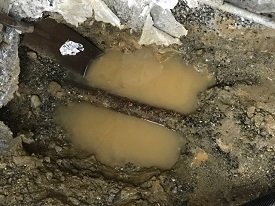Leak Detection

Leak Detection in Oregon (Eugene & Portland) and Washington State (Everett, Renton, Seattle, & Tacoma)
Understanding Acoustic Leak Detection
Underground water leaks in pressurized pipes may make many different sounds:
- “Hiss” or “Whoosh” from pipe vibration and orifice pressure reduction.
- “Splashing” or “Babbling Brook” sounds from water flowing around the pipe.
- Rapid “beating/thumping” sounds from water spray striking the wall of the soil cavity.
- Small “clinking” sounds of stones and pebbles bouncing off the pipe.
What Factors Affect These Sounds?
- Water pressure in the pipe
- Pipe material and pipe diameter
- Soil type and soil compaction
- Depth of soil over the pipe
- Surface cover: grass, loose soil, asphalt, concrete slab, etc.
The loudness or intensity of the leak sound is directly proportional to the water pressure inside the pipe (up to a limit):
Metal pipes, such as iron mains, copper services, and steel pipes, transmit water leak sounds that are a louder and higher frequency than PVC pipes or asbestos-cement pipes. Thus, knowledge of the pipe material is important.
Large-diameter (concrete, PVC, iron, steel, etc.) pipes transmit less sound from water leaks than small-diameter pipes. Large-diameter pipes also transmit lower frequency sounds than small-diameter pipes.
Sandy soil and very loose soils, particularly over a freshly buried pipeline, do not transmit the sounds of water leaks very well, nor do water-saturated soils such as bogs and swamps. Hard, compacted soil transmits the sounds of water leaks best. Soil absorbs the sounds of water leaks very quickly. Leaks in water lines that are only 3 or 4 feet deep are much easier to hear at the ground’s surface than leaks in deeper lines. At 7 or 8 feet deep, only very large leaks with good water pressure will produce enough noise to be heard at the surface.
Finally, the ground cover, whether an asphalt street, loose dirt, concrete slab, or grass lawn, also makes an important difference. Hard street surfaces and concrete slabs resonate with the sounds of the water leak, which may be heard for 5 to 10 feet or more on either side of the water pipe. Grass lawns and loose dirt surfaces do not offer such a resonating plate-like surface, and their surface variations make firm contact more difficult.
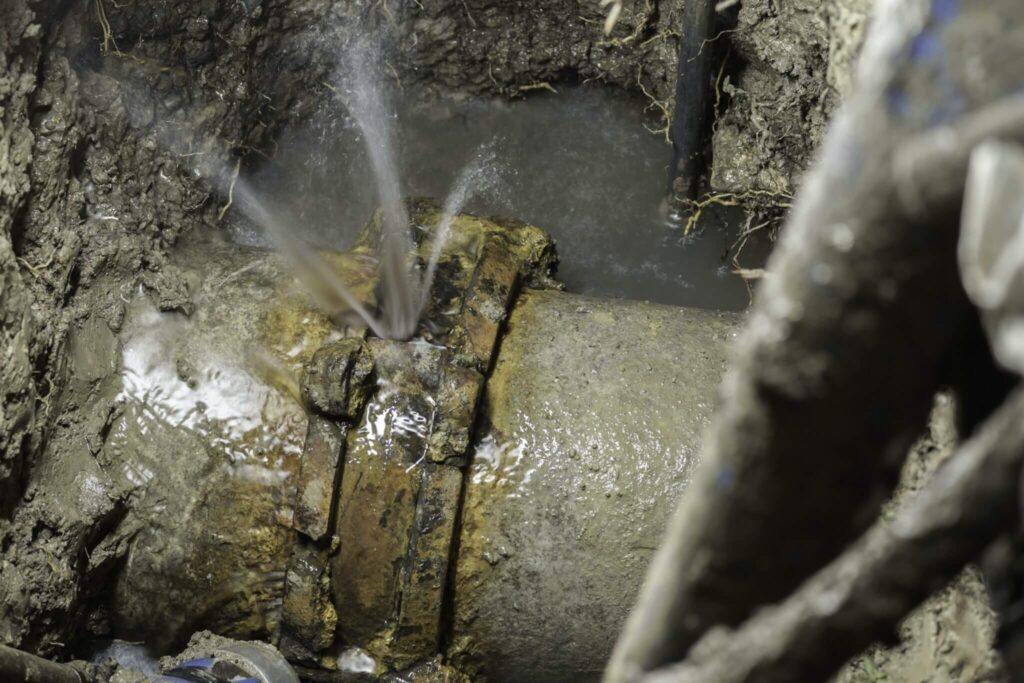
How Do Leak Sounds Travel on Pipes?
- Pipe Material and Diameter
- 6 inch Cast Iron Pipe
- 12 inch Cast Iron Pipe
- 24 inch Cast Iron Pipe
- 6 inch AC Pipe
- 12 inch AC Pipe
- 24 inch AC Pipe
- 6 inch PVC Pipe
- 12 inch PVC Pipe
- 24 inch PVC Pipe
- Distance Sounds Travel for 2 GPM Leak at 60 PSI
- 600 to 1000 feet
- 400 to 800 feet
- 200 to 400 feet
- 400 to 800 feet
- 300 to 500 feet
- 100 to 300 feet
- 200 to 300 feet
- 100 to 200 feet
- 100 to 200 feet
How Do Leak Sounds Travel Through Soil?
Soil absorbs water leak detection sounds very quickly:
Soil absorbs the high frequencies to a greater degree than the low frequencies. For a leak in a pipe 6 ft deep, the “Hiss” or the “Whoosh” sound is weak and “muted,” i.e., only the lower frequencies are heard. The sound is louder and slightly higher in frequency for a leak in a pipe 3 ft deep.
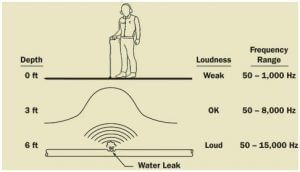

Surveying
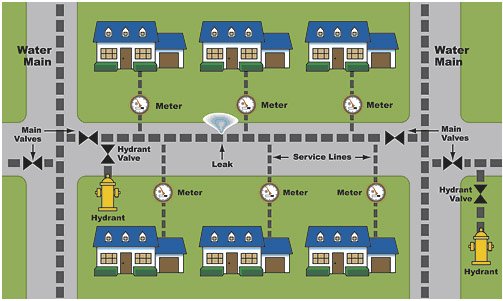
Surveying at a Hydrant and a Service Line:
Pinpointing
“Water Leak Pinpointing” is a common term that is applied for the process of pinpointing an exact leak location. For Acoustic Leak Detection the exact leak location is usually the spot where the leak sounds are the loudest. To find this spot, the leak detection expert must carefully mark the location of the water line in the work area with a pipe and cable locator. Usually, on water mains, the piping between the valve or hydrant with the loudest sound and the valve or hydrant with the second loudest sound is the section of the line that needs to be marked. The section must be accurately located and marked in the area for the leak detection expert to listen directly over the pipe consistently.
Expert technicians at an underground water leak detection company move the ground microphone 2 to 4 feet each time in the direction of the water line, listening and moving closer to the water leak. When a leak detection specialist is moving the microphone, they do not adjust the volume control since the volume control must be held constant to make accurate comparisons. When a leak detection specialist is very close to the leak, it may be impossible to decide, based on the user’s hearing alone, whether the leak is in one spot or 3 to 4 feet away. When this occurs, the leak detection expert must study the visible display (meter) to see if the signal is slightly stronger at one location than at another.
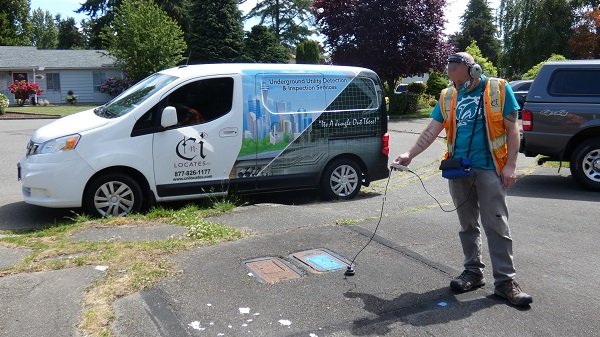
Leak Facts
- A 1/8-inch hole in a metal pipe, at 40 psi, leaks 2,500 gallons of water in 24 hours.
- A leak the size of a pinhead can waste 360,000 gallons per year, enough to fill 12,000 bathtubs to the overflow mark.
- A leaking toilet can use 90,000 gallons of water in 30 days.
- A dripping faucet/hose bibb can lose up to 180 gallons a month or 2,160 gallons per year.
- Approximately 1 in every 20 pools will have a leak.
- Approximately 1 in every 318 homes or buildings will have a leak.
- A typical toilet leak at today’s rate can add more than $500 to a single water bill.
- One trip through a car wash uses 150 gallons of drinking water.
- Collecting water for gardening from the faucet while waiting for hot water saves about 250 gallons a month.
- Using a broom to clean the sidewalk instead of a hose saves 150 gallons of water.
- Using a pool cover prevents about 1,000 gallons per month from evaporating.

You may have a plumbing leak if:
- You can hear the continuous sound of water (like a toilet running) when nothing is turned on.
- Your water meter reading continues to change when water isn’t being used. (Mark the indicator on your meter; don’t use any water for an hour; then check the meter. If the indicator moved, you might have a water leak.)
- Your water bill escalates for weeks or months. (Compare your bills month to month.)
- Your walls or floors have wet, spongy, moist, or discolored areas when nothing has been spilled.
- You can smell foul odors coming out of floors or walls near drains or sewers.
- Your building foundation cracks, vegetation grows unevenly, or the earth shifts for no apparent reason.
- You find warm spots on your floor, particularly on concrete slab floors.
Contact a professional plumbing leak detection service like CNI Locates when you are having troubles finding a plumbing leak.
You may have a pool/spa leak if:
- You lose 1/8″ of water or more in 24 hours. Perform a Bucket Test. Evaporation rates vary per area.
- You find algae forming too soon after a chemical treatment.
- You find loose or falling tiles or pool deck cracks. (All are signs that the surrounding ground is being compromised by water.)
- You pool/spa has settled into the ground or cracks and gaps appear in the pool shell or concrete deck.
- You find standing water, mushy spots, or uneven grass growth around the pool/spa area.
- Your automatic filler is continually releasing water.
Contact a professional pool leak detection service like CNI Locates when you are having troubles detecting pool leaks.
Pool & Spa Tips
- Do regular leak check-ups. A leak in the pool area can waste 1,000 gallons or more daily. Consult the SIGNS AND SYMPTOMS of the pool and Spa Leaks previously outlined
- Pay particular attention to your automatic water filler. If it’s faulty, your water bill suffers.
- Keep track of the number of chemicals you normally use. An increase in the quantity used can also be a sign of a leak.
- Use a pool/spa cover to cut down on water loss (and heating costs) caused by evaporation.

The “Bucket Test” will determine if water loss in a pool is due to evaporation or a leak:
- Bring pool water to the normal level.
- Fill a bucket with pool water to about one inch from the top
- Place the bucket on the first or second step of the pool.
- Mark the water level on the inside of the bucket.
- Shut off the pump and mark the pool level on the outside of the bucket.
- Resume normal pump operation.
- After 24 hours, compare the two levels. If the pool water (outside mark) goes down more than the inside water level, there is probably a leak.
- In case of rain, repeat the test.
- The test is not valid after 24 hours.
Contact a pool leak detection professional at CNI Locates for help detecting pool leaks & spa leaks.

The “Meter Test”:
- This test should be conducted for a 30-minute period, during which time no water is being used on the property.
- Find your water meter that is typically located outside your house in a covered box near the street.
- Check the flow indicator. If the flow indicator is spinning on an analog meter or a plus symbol is flashing on a digital meter, you most likely have a leak.
- Write down the numbers indicated on the meter at the start of this test.
- Return to check the meter reading after 30 minutes have passed.
- You should not have a leak in your pressurized water system if the numbers have stayed the same. If the numbers have changed, continue with the following steps.
- Shut off the valves under all toilets in the house and repeat steps 1-5.
- If the numbers on your water meter stayed the same after this process, you may have a running/leaking toilet that should be serviced. If the numbers have changed, this indicates water consumption even though the water was not being used during the test. Which means you may need help from an underground water leak detection company to find the leak.
Conservation Checklist
Speaking of saving, be sure to save this water leak inspection checklist. Hang it in a handy place – like your utility room. Use it to do a full leak detection check on your house four times a year. Just seeing it will remind you that conservation pays and preserves precious water.
Sometimes a small investment can pay large dividends. For example, buying a low-flush toilet can save over 18,000 gallons of water a year! It’s up to all of us – individuals, businesses, and industries – to save the earth’s resources. So, remember wherever you go, take your water consciousness along. What works at home, works at the office!
In General
- Watch for leaks. As outlined below, pay attention to the SIGNS AND SYMPTOMS of plumbing, pool, and spa leaks. Do a routine indoor/outdoor check every three months, or call a professional leak detection service to do one for you.
- Check all faucets for drips. If a drip fills an 8-ounce glass every quarter-hour, it will lose about 180 gallons per month. That’s 2,160 gallons a year, enough for 30+ showers or baths! Drips can usually be fixed by replacing inexpensive washers or valve seats.
- Install flow restrictors or other conservation devices on all faucets. With these in the shower alone, you can cut your water use from 5 to 10 gallons per minute to as low as 1.4 to 3 gallons per minute.
- Wrap exposed indoor and outdoor pipes to prevent breakage in freezing weather.
- If you notice water coming up from a slab you may have a water leak. We recommend that you contact a professional slab leak detection service company like CNI Locates.
In The Kitchen/Laundry
- One of the most common areas for water loss is the kitchen sink area. Check under cupboards once a week for wet spots or bowed cabinetry.
- Keep drinking water in the refrigerator so you don’t have to run the tap until the water gets cold enough.
- Only run full loads in your dishwasher
- Scrape food from plates with a utensil, not running water.
- Don’t continuously run water in the sink. Hand wash dishes in a sink full of soapy water; rinse all at once. Soak hard-to clean pans overnight.
- If you notice water dripping or rising from an area, you may have a water leak in your plumbing. Contact CNI Locates to find out more about our expert plumbing water leak detection services.
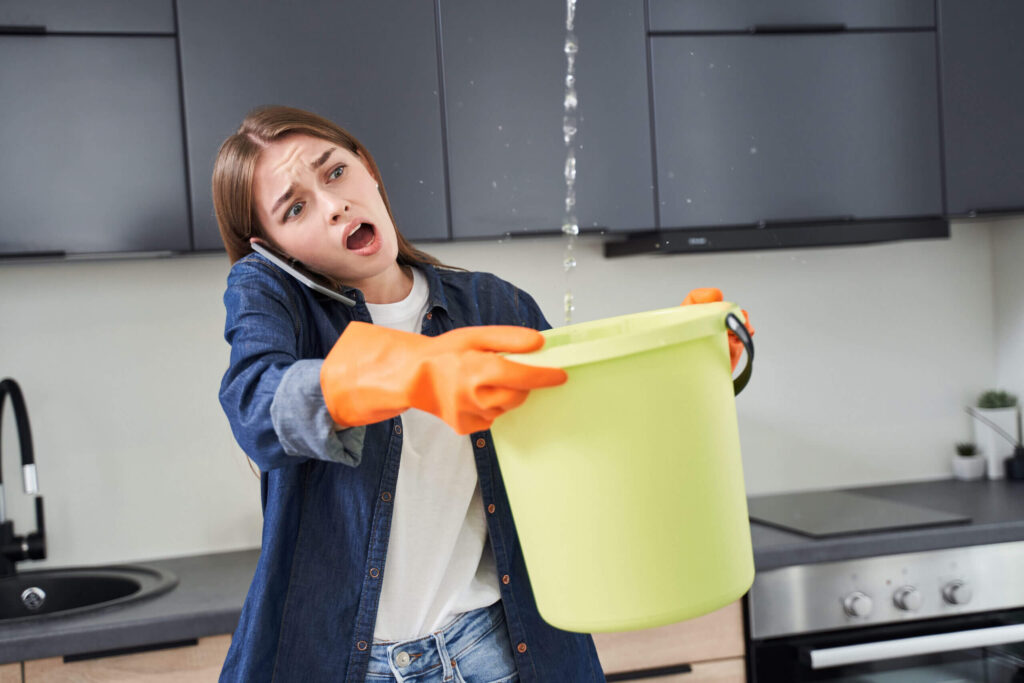
In The Bathroom
- Check sinks for drips or leaks once a week.
- Check the grout and tiles in the shower area. Is grout missing or loose, allowing water to flow beneath the tiles?
- Check toilets for leaks. Drop a teaspoon of food coloring into the tank. If the color appears in the bowl after 15 minutes, replace the “flapper” valve. If leaks continue, have a professional leak detection service check your system.
- Decrease the amount of water used per flush. Replace regular or older toilets with new ultra-low flush models or put water displacement devices inside every toilet tank. Make them from plastic water bottles weighted down with pebbles. DO NOT PUT BRICKS IN YOUR TANK. They can dissolve and clog siphon jets.

Outdoors
- Walk around your property once a week to look for spongy or mushy ground where broken pipes might be hidden.
- Check sprinklers for jammed or malfunctioning heads.
- Use accurate, efficient sprinklers or drip irrigation systems instead of hand watering.
- Water lawns during the coolest times of the day, before 10:00 a.m., or in the evening.
- Deep-soak lawns long enough for water to seep down to the roots, where it is needed. Water deeper and less often.
- Dig basins around individual plants to prevent run-off while watering.
- Put a layer of mulch around trees and plants to slow moisture evaporation.
- Landscape with native plants that take little water.
- Pull weeds as they steal water from desirable plants.
- Sweep driveways, sidewalks, and steps.
- If you notice your water meter is still moving when no water is being used and you have an irrigation system, you may need to hire an irrigation leak detection service.
- To test for an irrigation leak, check the water meter flow indicator to see if it is spinning (on an analog meter) or flashing (on a digital meter). If the flowmeter is spinning or flashing shut off the valve to the irrigation system and check the meter again. If the flowmeter stopped moving or flashing that means you have an irrigation leak and should contact a professional irrigation leak detection service.
- If the flow meter on your water meter is spinning or flashing and the main valve is shut off to your house or irrigation system, you may have an outdoor water leak. We recommend that you contact an outdoor water leak detection expert like CNI Locates to help find the leak.
Other Conservation Tips
- Replace old appliances with newer, more efficient, energy-saving models.
- Cut your air conditioner’s workload by positioning shade trees or awnings to reduce heat gain through windows.
- Close unused rooms.
- Close draperies
- Close fireplace dampers in the summer.
- Turn off lights when not in use.
Thermal Imaging Leak Detection
Thermal imaging is generally used to locate water leaks in building interiors. Still, it can also complement exterior leak detection methods and help quickly identify leaks or where moisture is gathering. If you need professional leak detection help to find interior leaks, or leaks along windows, roofs, floors, and around the usual water pipes inside your structure, call us today. We can pinpoint leaks and sources before you do any demolition work, saving you time and money.
We can use thermal imaging in conjunction with other water leak locating service applications. When we detect leaks, we think moisture or heat signatures can be useful to help provide a complete picture of your situation.
We use the FLIR MR176 and C3 with the MR40 Moisture Pen for infrared camera thermography for water leak detection.


